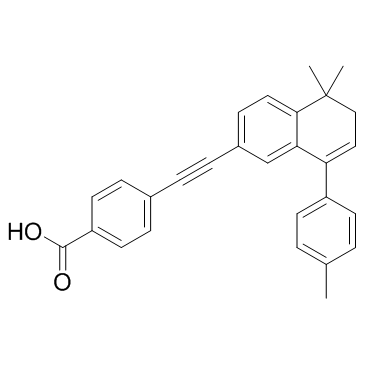AGN 193109 |
| رقم الكتالوجGC32817 |
AGN 193109 هو تناظرية ريتينويد ، ويعمل كمضاد محدد وفعال للغاية لمستقبلات حمض الريتينويك (RARs) ، مع Kds من 2 نانومتر ، 2 نانومتر ، و 3 نانومتر لـ RARα و RARβ و RARγ على التوالي
Products are for research use only. Not for human use. We do not sell to patients.

Cas No.: 171746-21-7
Sample solution is provided at 25 µL, 10mM.
AGN 193109 is a retinoid analog, and acts as a specific and highly effective antagonist of retinoic acid receptors (RARs), with Kds of 2 nM, 2 nM, and 3 nM for RARα, RARβ, and RARγ, respectively.
AGN 193109 is a highly effective antagonist of retinoic acid receptors, with Kds of 2 nM, 2 nM, and 3 nM for RARα, RARβ, and RARγ, respectively. AGN 193109 is completely RAR specific, because it does not bind to or transactivate through any of the RXRs[1]. AGN 193109 (100 nM) inhibits the TTNPB (a retinoic acid receptor agonist)-dependent morphological change in ECE16-1 cells. AGN193109 half-reverses retinoid-dependent growth suppression at 10 nM, and completely shows this effect at 100 nM in ECE16-1 cells. AGN193109 (100 nM) also eliminates TTNPB-induced decrease in levels of K5, K6, K14, K16, and K17 and increase in levels of K7, K8, and K19[2].
AGN 193109 (1.15 μmol/kg) does not causes overt toxicity and has no effect on spleen weight on the mice, but it suppresses TTNPB-induced increase in spleen weight of the mice. AGN 193109 also significantly reduces the cutaneous toxicity induced by ATRA. AGN 193109 (0.30 or 1.20 μmol/kg) by topical treatment significantly reduces both weight loss and cutaneous toxicity caused by oral TTNPB cotreatment[3].
[1]. Johnson AT, et al. Synthesis and characterization of a highly potent and effective antagonist of retinoic acid receptors. J Med Chem. 1995 Nov 24;38(24):4764-7. [2]. Agarwal C, et al. AGN193109 is a highly effective antagonist of retinoid action in human ectocervical epithelial cells. J Biol Chem. 1996 May 24;271(21):12209-12. [3]. Standeven AM, et al. Specific antagonist of retinoid toxicity in mice. Toxicol Appl Pharmacol. 1996 May;138(1):169-75.
Average Rating: 5 (Based on Reviews and 4 reference(s) in Google Scholar.)
GLPBIO products are for RESEARCH USE ONLY. Please make sure your review or question is research based.
Required fields are marked with *




















